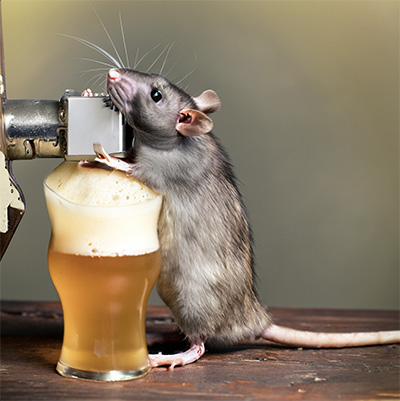 Watchdogging
Watchdogging  In the Doghouse
In the Doghouse  The Cruel Trade: With AB 840, Big Alcohol Buys Underage Eyes
The Cruel Trade: With AB 840, Big Alcohol Buys Underage EyesThe Cruel Trade: With AB 840, Big Alcohol Buys Underage Eyes
The alcohol industry is running an experiment, of the kind sometimes carried out in college psych labs. In this experiment, a young student—19 or 20 years old—is shown a lever. The experimenter urges them to pull it. If they do, they are subjected to a random outcome: they might feel happy, or nauseous, or they will receive a shock, and, rarely, killed.
 This seems absurd, cruel, and reckless, a deeply unethical experiment, even more so if it happens to be run at the financial behest of a donor. But at Big Alcohol's behest, Cal Poly San Luis Obispo is doing just that kind of experiment. They are pushing to be allowed to sell alcohol advertising throughout the recreational facilities used by the school’s undergraduates, many of whom are below the legal drinking age.
This seems absurd, cruel, and reckless, a deeply unethical experiment, even more so if it happens to be run at the financial behest of a donor. But at Big Alcohol's behest, Cal Poly San Luis Obispo is doing just that kind of experiment. They are pushing to be allowed to sell alcohol advertising throughout the recreational facilities used by the school’s undergraduates, many of whom are below the legal drinking age.
“Alcohol ads are not neutral,” said Cruz Avila, Executive Director of Alcohol Justice. “They are meant to persuade, and they don’t ID someone before they persuade them. As a father who has studied and researched the consequences of reckless drinking on underage Californians, it’s unforgivable that a school would sell its students to Budweiser for pocket change.”
Cal Poly, along with seven other California State University campuses as well as St. Mary’s College of California, are sponsors of AB 840, a bill authored by Democratic Assemblymember Dawn Addis that will let the universities sell space to alcohol advertisers in stadiums and event centers. The universities are pushing for this in a desperate scrounge for funding. In testimony before the California Senate Governmental Operations Committee, Cal Poly Assistant VP of Strategic Business Services Dru Zackmeyer noted that “operating budgets are always tight. Sponsorships with local alcoholic beverage suppliers and manufacturers based in part on advertising opportunities… provide hundreds of thousands of discretionary dollars.”
Yet Zackmeyer also acknowledged that these advertising policies would not just put college students in the crosshairs. University facilities serve as community hubs, including for youth gatherings. Zackmeyer noted that the Cal Poly Performing Arts Center would be a beneficiary of these ads, and would in turn spend that money to “allow 12,000 K through 12 students to experience live educational arts performances.”1
The rationale—market alcohol to middle schoolers so you can maintain a facility to market alcohol to middle schoolers—would be merely bleak if it were financially effective. But the actual effectiveness of this strategy was questioned by the California Assembly Appropriations Committee analysis which noted the yearly revenue would be “…potentially in the low millions of dollars annually.” For context, the CSU System budget is $12.4 billion per year. And this is only cost neutral if, in fact, alcohol advertising has no effect, particularly on the 40% of the CSU system under 21.2 Research shows, however that this is not the case.
Alcohol marketing absolutely impacts underage young adults. Studies have shown that exposure to alcohol ads increases intention to drink and likelihood of binge drinking3—and an 18-year-old high school senior is just as vulnerable to this as an 18-year-old college freshman. When you raise alcohol consumption in this cohort, you raise the consequences, and those consequences range from uncomfortable to lethal.
Alcohol consumption in college is associated with a range of concerns, according to the National Institute on Alcohol Abuse and Alcoholism. Aside from simple academic problems as a consequence of drinking, collegiate alcohol use is associate with legal problems, violent assault, and sexual assault.4 In the worst case, alcohol can become a killer.
Or to look at it the other way, when the worst case occurs, it very likely derives from alcohol use. The top three causes of death for those underage are alcohol related: motor vehicle crashes, homicide, and suicide.5 As the opioid crisis bleeds into all facets of modern life, so too do alcohol-involved overdoses spike among young people. In these cases, alcohol’s tendency to make the body more sensitive to opioids and other downers turns nonlethal doses fatal.
It is easy but callous to brush these aside as the consequences of individual bad decisions. And historically, Big Alcohol has used that framework to avoid regulation that could reduce these life-altering outcomes.6 But in the case of college students, the consequences are often imposed by the university itself. Most universities have codes of conduct that preclude underage drinking on campus, with consequences up to and including expulsion.
“It is absolutely Kafkaesque to urge someone to do something that you intend to punish them for,” said Carson Benowitz-Fredericks, Research Director at Alcohol Justice. “It’s frankly cruel for CSU to take money to urge 19-year-olds to drink, suspend them for listening, and then tell them it’s all for their own benefit.”
Because of the harm to students from drinking and the harm to the university from students leaving the system, it becomes increasingly difficult to realize the economic advantage. At last estimate, underage drinking cost California $7.3 billion, including underage college students.7
The CSU system still fights its own battles against rampant disruption and death due to alcohol, as exemplified by the plight of San Diego State University in the wake of its own exemption from alcohol advertising restrictions.8 And the system at large has dedicated $25 million—far, far more than will be brought in by advertising to its students—to address rampant sexual misconduct concerns.9 Since so many of these consequences are tied to drinking, it puts CSU in a bind.
Either:
- The alcohol advertising is ineffective, in which case the ads will be pulled and they will lose the money, or
- The alcohol advertising is effective, in which case consumption goes up, the costs and fallout goes up, and CSU loses more money than it raises.
The alcohol industry clearly thinks the advertising will work. Industry documents show they are well aware that their products and campaigns capture the attention of people who are too young to drink.10 By simply splashing them up in a mixed crowd—40% underage, 60% legal age—they can claim they were only trying to market to those 21 years of age and older. Worse, AB 840 gives Big Alcohol permission to violate even their own voluntary marketing restrictions. When asked to set a limit for underage audience for alcohol ads, the industry vowed not to use a channel where more than 28.4% of the audience was underage.11 The audience at CSU, of course, is 40% underage.
“I can see the industry saying, ‘If CSU doesn’t care, why should we?” said Michael Scippa, Public Affairs Director for Alcohol Justice. “If CSU doesn’t care about kids dropping out, crashing their cars, getting assaulted… why should Big Alcohol?”
Alcohol Justice and the California Alcohol Policy Alliance ask concerned community members to reach out to Assemblymember Addis, representatives at Cal Poly, and legislative leaders in Sacramento, to tell them to stop sacrificing youth on the altar of alcohol industry profits. This has hurt too many California kids before and will do it again. Whatever the money offered, the real price is too steep.
To send a message to Sacramento, TAKE ACTION here: http://bit.ly/44n481d
REFERENCES
1. California State Senate Governmental Operations Committee. July 11, 2023 legislative session. Available at: https://www.youtube.com/watch?v=6rttXJJUIHE. (Comments start at 1’18”.)
2. California Polytechnic State University. (2023). “Institutional Research.” Available at: https://ir.calpoly.edu/content/publications_reports/polyview/index. Accessed August 11, 2023.
3. Jernigan, D., Noel, J., Landon, J., Thornton, N., & Lobstein, T. (2017). Alcohol marketing and youth alcohol consumption: a systematic review of longitudinal studies published since 2008. Addiction, 112, 7-20.
4. National Institute on Alcoholic Abuse and Alcoholism. (2023). “Harmful and Underage College Drinking.” Available at: https://www.niaaa.nih.gov/publications/brochures-and-fact-sheets/college-drinking. Accessed August 11, 2023.
5. Centers for Disease Control and Prevention. CDC WONDER. Available at: https://wonder.cdc.gov/. Accessed August 11, 2023.
6. Mialon, M. & McCambridge, J. (2018) Alcohol industry corporate social responsibility initiatives and harmful drinking: a systematic review. European Journal of Public Health, 28(4), 664-73.
7. Miller, TR, Levy, DT, Spicer, RS, & Taylor, DM. (2006) Societal costs of underage drinking. Journal of Studies on Alcohol, 67(4) 519-28.
8. Ramirez, J. “Vodka Billboard with SDSU Athletics Logo Stirs Controversy.” November 15, 2022. CBS. Available at: https://www.cbs8.com/article/news/local/vodka-billboard-with-sdsu-logo-stirs-controversy/509-2224c972-a3d1-44e5-8019-e7d484de43b9. Accessed August 22, 2023.
9. Zinshteyn, M. “How Many Cal State Employees Are Accused of Sexual Harassment? Here’s Why It’s Hard to Know.” August 7, 2023. Cal Matters. Available at: https://calmatters.org/education/higher-education/2023/08/sexual-harassment/. Accessed August 22, 2023.
10. Hill, S.C., Thomsen, S.R., Page, R.M., & Parrott, N. (2005). Alcohol advertisements in youth-oriented magazines: Persuasive themes and responsibility messages. Journal of Health Education, 36(5), 258-265.
11. Beese, J. “Please Link Responsibly: Social Media Guidelines for Alcohol Marketing.” March 30, 2015. Sprout Social. Available at: https://sproutsocial.com/insights/social-media-alcohol-marketing/. Accessed August 11, 2023.
Help us hold Big Alcohol accountable for the harm its products cause.
| GET ACTION ALERTS AND eNEWS |
STAY CONNECTED    |
CONTACT US 24 Belvedere St. San Rafael, CA 94901 415-456-5692 |
SUPPORT US Terms of Service & Privacy Policy |

